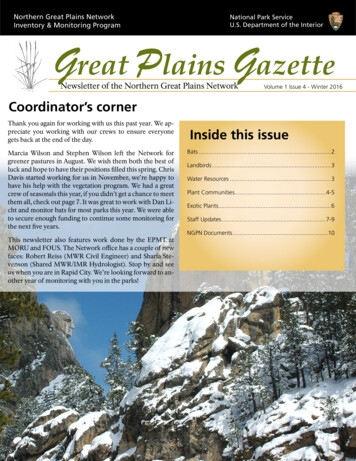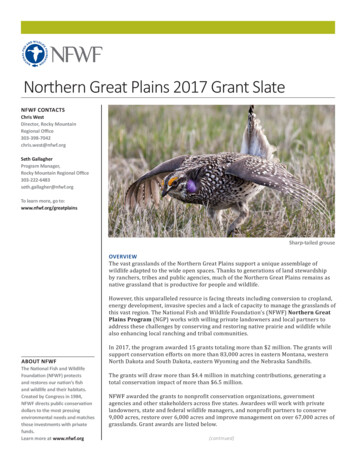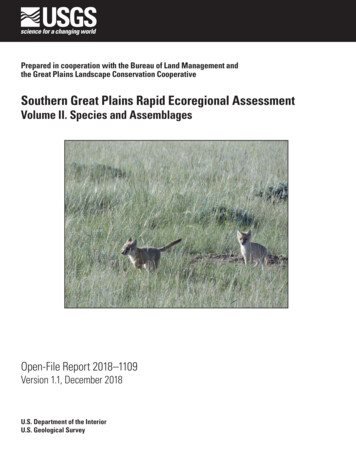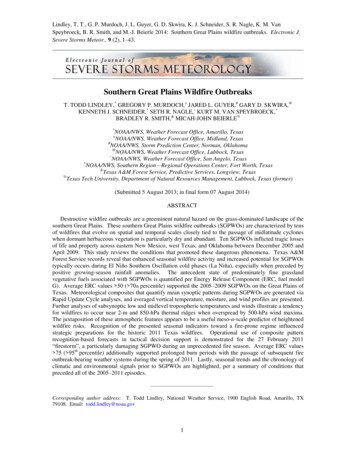
Transcription
Northern Great Plains NetworkInventory & Monitoring ProgramNational Park ServiceU.S. Department of the InteriorGreat Plains GazetteNewsletter of the Northern Great Plains NetworkVolume 1 Issue 4 - Winter 2016Coordinator’s cornerThank you again for working with us this past year. We appreciate you working with our crews to ensure everyonegets back at the end of the day.Marcia Wilson and Stephen Wilson left the Network forgreener pastures in August. We wish them both the best ofluck and hope to have their positions filled this spring. ChrisDavis started working for us in November, we’re happy tohave his help with the vegetation program. We had a greatcrew of seasonals this year, if you didn’t get a chance to meetthem all, check out page 7. It was great to work with Dan Licht and monitor bats for most parks this year. We were ableto secure enough funding to continue some monitoring forthe next five years.This newsletter also features work done by the EPMT atMORU and FOUS. The Network office has a couple of newfaces: Robert Reiss (MWR Civil Engineer) and Sharla Stevenson (Shared MWR/IMR Hydrologist). Stop by and seeus when you are in Rapid City. We’re looking forward to another year of monitoring with you in the parks!Inside this issueBats.2Landbirds.3Water Resources.3Plant Communities.4-5Exotic Plants.6Staff Updates.7-9NGPN Documents.10
BatsBat Monitoring in Full FlightNational Program to Monitor Bats Established at NGPN parksThis summer marked the second year of bat monitoring by theNetwork. In 2015, the monitoring was expanded to include allNetwork parks with the exception of Devils Tower NM whichhas its own bat monitoring program. Badlands, Jewel Cave, Missouri, Niobrara, Theodore Roosevelt, and Wind Cave all met criteria for monitoring using the North American Bat Monitoring(NABat) sampling frame. The NABat protocol calls for placing4 stationary monitors within a 10x10 km cell for a minimum of4 nights. Road surveys were also conducted at those parks following the NABat protocol. Data from these surveys will feeddirectly into continent-wide monitoring of bat populations.The other parks in the Network were monitored using the samehardware; however, the deployment locations were not limitedby the NABat framework.The Network has now established 55 NABat monitoringstations and 62 non-NABat stations. From 2014-15, 908 nightswere monitored resulting in451,107 bat recordings, or anaverage of 497 detections pernight. The highest number ofdetections per night (3,771) occurred at the station next to thebat house at Fort Laramie (seecenter image). Stations next tosurface water and trees also hadhigh rates of detections. Stations in prairie away from waterThomas Rains deploying a recorder at MORUand trees typically had fewer detections.Species identification is ongoing,but preliminary results suggestthat the most common species inthe Network are the big brown,silver-hair, and little brown bats.The Eastern red, hoary, Western small-footed myotis, andlong-legged myotis were moderately common. Other species,including the threatened Northern long-eared bat, appear to bepresent in small numbers.Mobile surveys are an effectiveway to track abundance as theyare not susceptible to repeatedflyovers by the same bat. Nine routes were surveyed in both 2014and 2015. Seven routes had fewer bats detected in 2015 than in2014 (see chart to left); however, the difference was not statistically significant. The increase in data collection in 2015 wouldnot have been possible without Thomas Rains, a seasonal forNGPN. His night work and extensive travelling was appreciated.Bat House at FOLAIn 2016, the monitoring at the NABat parks will be conducted bythe University of Wyoming through an agreement with the Network. Monitoring at the non-NABat parks will be conducted bythe MWRO Biologist.2 Winter 2016 - Great Plains Gazette
Landbirds and Water ResourcesBirds of a Feather, Monitor TogetherAll 13 Parks Monitored in 3rd Year of ProgramThis summer the Network continued its cooperative agreements with the Bird Conservancy of the Rockies (formerly Rocky Mountain Bird Observatory) to conduct bird surveys. Landbird presence and abundance was sampledat all 13 parks in the Network from mid-May to late-July. Network ecologists and data managers worked with theBird Conservancy to develop a sampling design for MNRR, and it was surveyed for the first time this summer following the new protocol. We are also working with Dr. Bob Gitzen, a university partner, to help us develop tools for thestatistical analysis of bird counts. We look forward to using thesetools to produce more reports for our parks in the future. Untilthen, Landbird Resource Briefs are written annually for each park.All of the Network’s bird data are located at the Avian DataCenter. If you would like to look at 2013, 2014, or 2015 birddata for your park, please contact Angela Jarding and she canwalk you through the steps.Yellow-rumped warblerTurning on the WaterworksSensors Deployed at FOLA and MNRRIn 2015, the Network set up interagency agreements with United States Geological Survey (USGS) Water Science Centers inWyoming-Montana and Nebraska to collect water quality dataat two sites during the ice free season (early spring to late fall).One site was at the USGS Gaging Station 06670500 LaramieRiver near Fort Laramie, Wyoming. The other site was alongBow Creek in Nebraska and was selected by Missouri NRRstaff. While the site at Fort Laramie has measured stream flowsince 1915, the Bow Creek site was a new location for USGS.Data are available in real-time from the USGS website and include measures of dissolved oxygen, pH, specific conductance,water temperature, and streamflow. The data collected this season clearly shows flooding on the Laramie River during Mayand June (graph to the left). We plan on hiring a newecologist this winter that will help us with comparContinuous data from all water quality monitoring sitesing the collected data with historic averages and statecan be accessed from links on the Network’s website.and federal water quality standards.Winter 2016 - Great Plains Gazette 3
Plant CommunitiesAnother Successful Season5th Season of Vegetation Monitoring CompleteThe NGPN vegetation monitoring crew has successfully completed its fifth season ofPlant Community Monitoring! During the months of May through September the crewvisited a total of 108 long-term monitoring plots in eleven parks across four states.We are once again happy to report an injury-free season. The crew managed to avoidpotential injury from hazards such as hidden prairie dog holes, chilly river crossings, andsurprise bison encounters. Thanks to the resourcefulness and cunning observation skillsof the crew, everyone made it through the summer safe and sound.As with previous seasons, we again welcomed field assistance from varying organizationsand parks. We were fortunate enough to receive assistance from the Natural Resourcesstaff at DETO, volunteers from JECA and MORU, and an entire botany class from Dickinson State University. It was a pleasure for us to teach others about our line of work andlearn about areas outside of vegetation management.Though data analysis from this season is still preliminary, some interesting trends canbe seen. Primarily, seasonal precipitation seems to directly influence species diversityacross all parks. The drought yearof 2012 shows the lowest diversity in the five years of data collection, while the particularly rainysummers of 2014 and 2015 havethe highest. The graph representsplant species richness from WICA(pictured at right), but similartrends are seen across all of ourparks. This winter, we plan onwriting lots of reports summarizing the first five years of vegetationmonitoring at each park.Vegetation Crew monitoring with DETO staff4 Winter 2016 - Great Plains Gazette
Plant CommunitiesTheodore Roosevelt Forest MonitoringInvestigating Riparian Forests Along the Little MissouriThe vegetation program monitors foreststructure and health on a five year cycle. In2015, THRO was the final park to be visited.Our focus was on the riparian woodlands adjacent to the Little Missouri River. Over multiple visits this fall, 100 plots were installedand read across the North and South Unitsof the park. We counted the number of seedlings, measured the size of trees, looked forexotic species of concern, and surveyed treevigor at each site.The crew encountered many obstacles overthe course of their four weeks of work at thepark. The nature of the terrain and hydrology resulted in numerous river crossings requiring navigational mastery. Overall, the crew covered 30 miles in the South Unit and60 miles in the North Unit on foot. With 50 plots in each unit spread across all reachesof the river corridor, the crew travelled to areas of the park rarely visited. This allowedfor discovery of majestic mature cottonwood trees, frequent friendly bison encounters,and even the rare opportunity to observe a large moose traversing the badland landscape.The data collected this fall will provide a baseline for continued monitoring of THRO’sriparian forests. We plan on producing a report to share with the park and public in thespring of 2016. Our hope is that these data help park managers better understand current conditionsand future trends in the healthof the riparian forests alongthis stretch of the LittleMissouri River.Navigating Badlands at THROWinter 2016 - Great Plains Gazette 5
Exotic PlantsBattling Invasive SpeciesNPS Academy Intern at MORUCollaboration between the Northern Great Plains ExoticPlant Management Team (NGP EPMT) and Mount RushmoreNMEM resulted in a NPS Academy Student Conservation Association intern funded by the NPS Academy program to be stationed at Mt. Rushmore for the 12 week program. Our intern,Amie Schiller, was able to complete several projects during hertime at the park. Projects included exotic invasive species inventory and treatment, hazard tree inventory, and planting a pollinator garden in the developed area of Mt. Rushmore. Amiewas also able to assist the NGP EPMT crews at Jewel Cave andWind Cave National Park as well as helping the Northern GreatPlains Inventory and Monitoring Program read vegetation plotsat Wind Cave.Amie Schiller planting pollinator garden at MORUEngaging youth in protecting our natural resources was a priority this year and this project demonstrates the benefits of employing youth to work in our parks. They gained an understanding of the complexities in managing natural resources and the uniquechallenges of conducting active management of resources. We will continue our partnerships with youth organizations in the futureand hope to expand their opportunities to include other natural resource disciplines in the parks that we serve.Treating the Bodmer Unit at FOUSThe NGP EPMT and Ft. Union Trading Post staff has worked since 2002 to control invasive species such as leafy spurge, Canadathistle and musk thistle in the Bodmer Unit of the park. Although treatments did not occur every year, crews have been diligent intreating high priority areas. New herbicides such as Perspective have reduced the number and amount of herbicides used in the parkas well as increasing efficacy of the current treatments. Field crews can now use one herbicide in one treatment instead of two or threeherbicides spread over several treatments as in the past.The Bodmer Unit is a unique cultural landscape in that it was the site of Karl Bodmer’s paintings of Ft. Union and Native Americanswhen he accompanied Prince Maximilian on his expedition to the American West in the summer of 1833. Although the landscape haschanged since the 1830’s, we still hope visitors can experience the site similar to what Karl Bodmer captured in his famous watercolorpaintings. Now that the site is in a controlled state for invasive species, it will allow NGP EPMT and park staff to focus on other highpriorities areas within the park and continue to improve the ecological condition of this important cultural landscape.NGP EPMT and Montana Conservation Corps crews treating the Bodmer Unit of FOLA6 Winter 2016 - Great Plains Gazette
Staff UpdatesSo Long Seasonal StaffWe would like to give one final thank youto our seasonal biological technicians whosetireless efforts provided the network withanother year’s worth of valuable data!Daina JacksonJoseph LaddLogan LaFleurThis summer was Daina’s third seasonwith NGPN. Her favorite part of thejob was discovering new remote partsof each park. She plans on spendingher winter in Custer, SD relaxing andif the weather is nice riding her motorcycle.This summer was Joseph’s secondseason with NGPN. He loved the constant challenge the job provided himwith and the chance to visit beautifulremote areas of the parks. This winterJoseph plans on relaxing in WesternWA with friends and family.This summer was Logan’s first with theNGPN. Having grown up locally, shewas familiar with many of the parks,but several she visited for the first time.This winter she’ll be participating inNational Novel Writing Month andspending time with family.During his first season with NGPN,Chris enjoyed working in areas of theNational Parks that are off the beatenpath. He is looking forward to starting a new job as a student contractorfisheries technician with the USGS inYankton, SD this winter.Lee hails from Northwest Montana,and he loves that people are willing topay him to hike around and look at thecool things that grow in the dirt. Thiswinter he hopes to either travel to faraway lands or hole up and eat lots ofsoup.Chris BoeverLee MickelsonThis was Stephanie’s third seasonwith NGPN. Her favorite part of thisseason was seeing all the fall colorchanges at THRO. During her winteroff, Stephanie hopes to visit family andfriends, and maybe go on an adventureto somewhere new!Stephanie RockwoodWill had a fantastic time in his first season with the Network. He enjoyed theamazing opportunity to see all of theamazing parks up close and first hand.Will plans on staying in the area thiswinter and hopes to return to the Network next spring.Will Vogel2015 Vegetation Crew enjoying SCBLWinter 2016 - Great Plains Gazette 7
Staff UpdatesFarewellsSaying Goodbye to Staff MembersMarcia WilsonDr. Marcia Wilson became the new program manager for the Chihuahuan Desert I&M Network based in Las Cruces, New Mexico in August 2015. Marcia worked for the NGPN since 2003 as an Ecologist. Shewas involved in the selection process of the NGPN vital signs and wasa co-author on the Network’s Monitoring Plan. As the General Ecologist for NGPN, she was the lead on landbird, water quality, and macroinvertebrate vital signs. The NGPN land bird monitoring protocol was ajoint effort with the Chihuahuan Desert, Southern Plains, and SonoranDesert I&M Networks, as well as Rocky Mountain Bird Observatory(RMBO). For the water quality vital sign she developed the Water Quality Monitoring Protocol as a partnership with the United State Geological Survey. We miss Marcia, and look forward to opportunities to collaborate with her in her new position.Stephen WilsonIn August of 2015, Stephen Wilson left NGPN to become a GIS Technician at the DOI Office of the Special Trustee for American Indians withthe Office of Appraisal Services, Land Buy-Back Valuation Program.Stephen served as the Data Manager and Biologist for the NGPN sinceFebruary 2010. He has been involved with natural resource inventories, as well as the development and implementation of all the Network’s protocols including plant community, land bird, water quality,and prairie dog monitoring. Prior to working for NGPN, Stephen spent10 years working as a Natural Resource Manager at the Missouri National Recreational River. We miss Stephen already, but lucky for us hisnew office is just a few blocks away and can still be reached when weneed a little assistance!8 Winter 2016 - Great Plains Gazette
Staff UpdatesNew FacesA warm welcome to our new staffSharla StevensonSharla Stevenson started working for the National Park Service in 2009 at the Water RightsBranch in Fort Collins, Colorado. She moved to Rapid City, South Dakota in October to beginworking as a regional hydrologist. Sharla is available to assist parks and networks in Midwestand Intermountain regions with hydrologic problems including Wild and Scenic River issues.She earned her undergraduate degree at Texas A&M University and her M.S. degree at Colorado State University. Her graduate focus was on data analytics and using stochastic modeling toforecast the effect of changes in climate on water supplies. Sharla can be reached at Sharla Stevenson@nps.gov or via phone at 605-939-8058.Adam WeaverThis is Adam’s first year as an employee with the NPS working as aGIS and Data Management Technician. He is involved as a volunteertrip leader in both Wind and Jewel Caves, working on the mappingprojects and the ongoing exploration of these systems. The NGPNhas been a great place to learn more about the NPS and the parks inour area.Chris DavisChris has previously worked at Rocky Mountain and Yosemite NationalParks where he designed and implemented studies to evaluate revegetation and ecological restoration, exotic species management, and rare plantspecies distributions. Chris will be the vegetation field lead at NGPN. Hehas a BS in Life Sciences from Arizona State University and recently completed work on his MS in Ecology from Colorado State University, wherehe studied the effects of herbicide applications on plant communities inRocky Mountain NP. He’s looking forward to experiencing working insmaller park service units and exploring the Black Hills with his family.Winter 2016 - Great Plains Gazette 9
Northern Great Plains NetworkInventory & Monitoring ProgramNational Park ServiceU.S. Department of the InteriorAcronymsAGFOAgate Fossil Beds NationalMonumentBADLBadlands National ParkDETODevils Tower NationalMonumentFOLAFort Laramie National HistoricSiteFOUSFort Union Trading PostNational Historic SiteJECAJewel Cave National MonumentKNRIKnife River Indian VillagesNational Historic SiteMORUMount Rushmore NationalMemorialMNRRMissouri National RecreationalRiverNGP EPMTNorthern Great Plains ExoticPlant Management TeamNGPNNorthern Great Plains NetworkNIOBNiobrara National Scenic RiverNABatNorth American Bat MonitoringProgramRMBORocky Mountain BirdObservatorySCBLScotts Bluff NationalMonumentTHROTheodore Roosevelt NationalParkUSGSU.S. Geological SurveyNorthern Great Plains Network231 East St. Joseph StreetRapid City, SD he Great Plains Gazette is a publication ofthe Northern Great Plains Inventory & Monitoring Network. All photos in this documentare courtesy of the National Park Service unless otherwise noted.Network CoordinatorKara Paintner-GreenNGPN DocumentsAvailable for download on our website!Resource BriefsLandbird Monitoring Results 2014Agate Fossil Beds NMBadlands NPDevils Tower NMFort Laramie NHSFort Union Trading Post NHSJewel Cave NMMount Rushmore NMEMNiobrara NSRKnife River Indian Villages NHSScotts Bluff NMTheodore Roosevelt NPWind Cave NPLandbird Monitoring Results 2015Badlands NPMissouri NRRNiobrara NSRReportsPlant Community Monitoring Annual Reports 2014Agate Fossil Beds NMBadlands NPDevils Tower NMFort Laramie NHSFort Union Trading Post NHSJewel Cave NMMount Rushmore NMEMKnife River Indian Villages NHSScotts Bluff NMTheodore Roosevelt NPWind Cave NPWater Quality Monitoring Protocol 2014Editing and DesignJoseph LaddContributorsKara Paintner-GreenJoseph LaddAngela JardingDan LichtIsabel AshtonBrennan HaukChris DavisSharla StevensonAdam WeaverWinter 2016 - Great Plains Gazette 10
Winter 2016 - Great Plains Gazette 3 Landbirds and Water Resources This summer the Network continued its cooperative agreements with the Bird Conservancy of the Rockies (for-merly Rocky Mountain Bird Observatory) to conduct bird surveys. Landbird presence and abundance was sampled at all 13 parks in the Network from mid-May to late-July.










